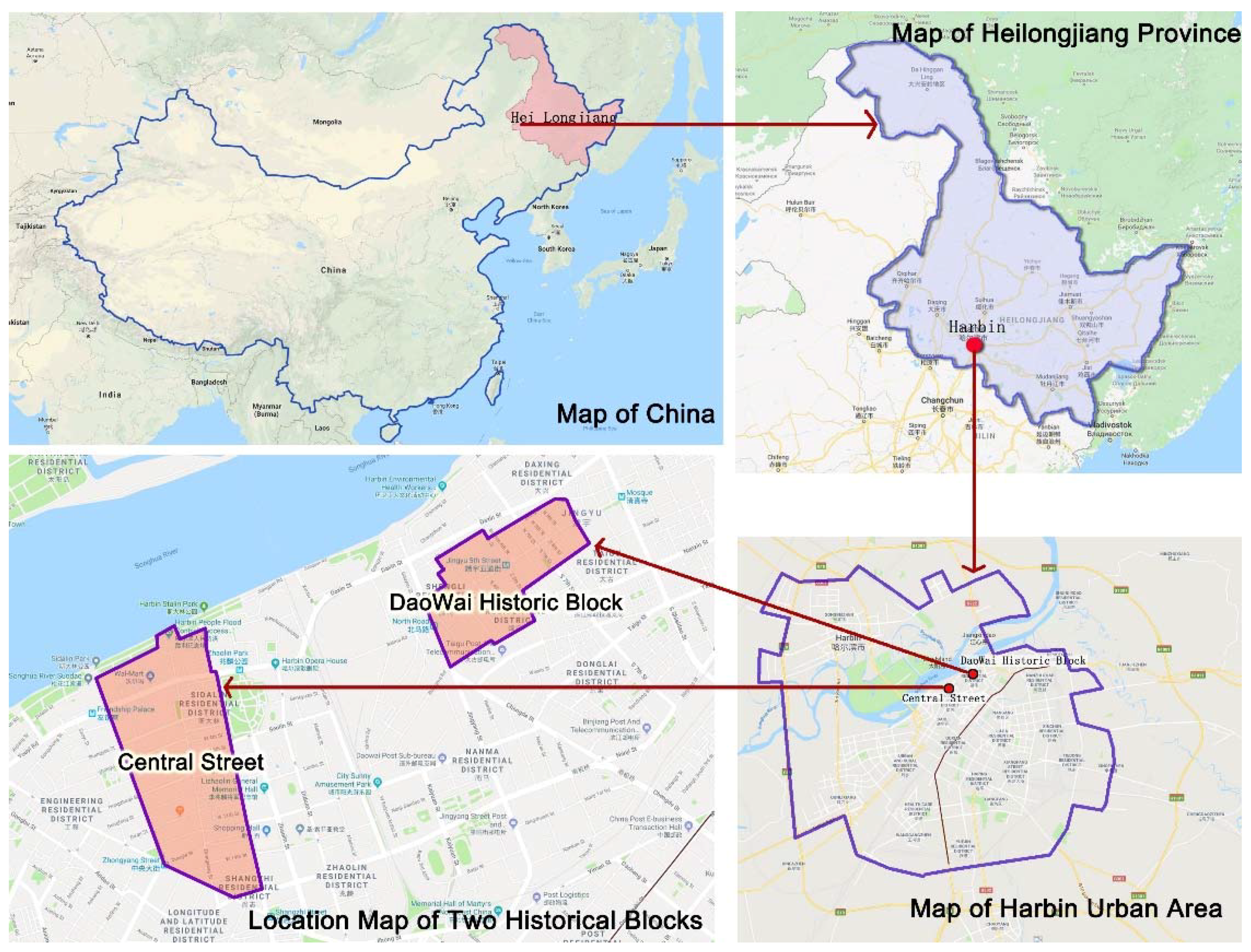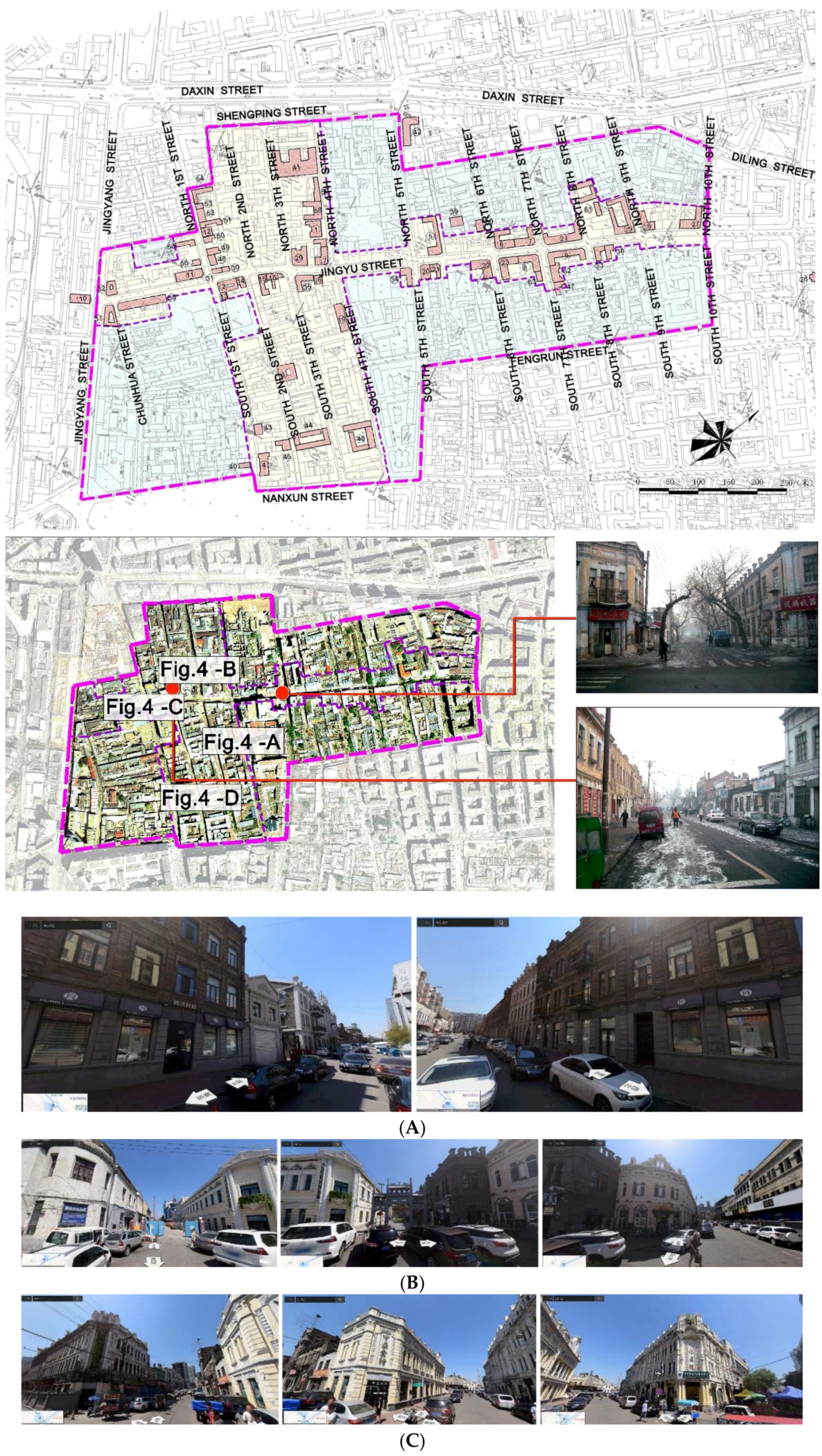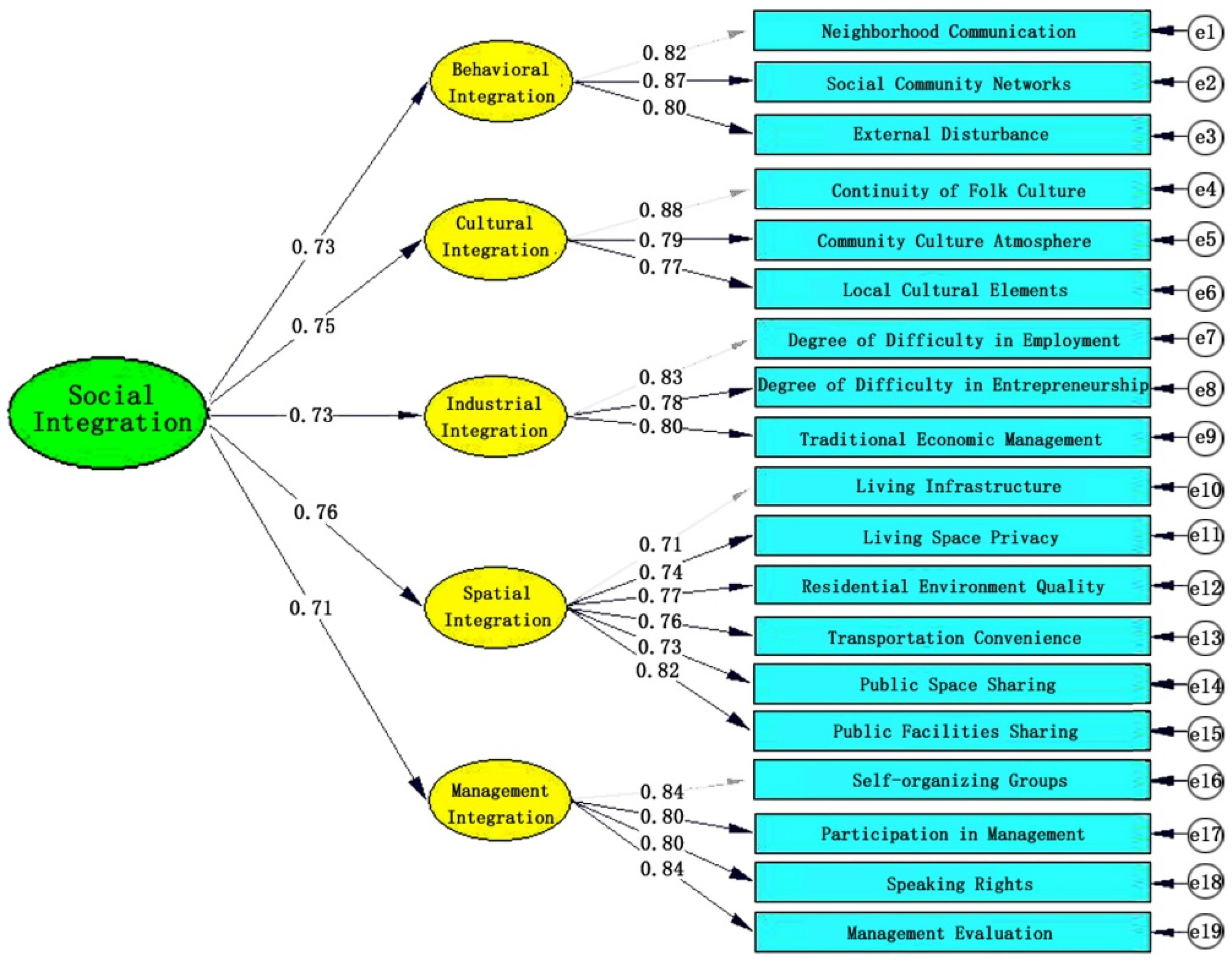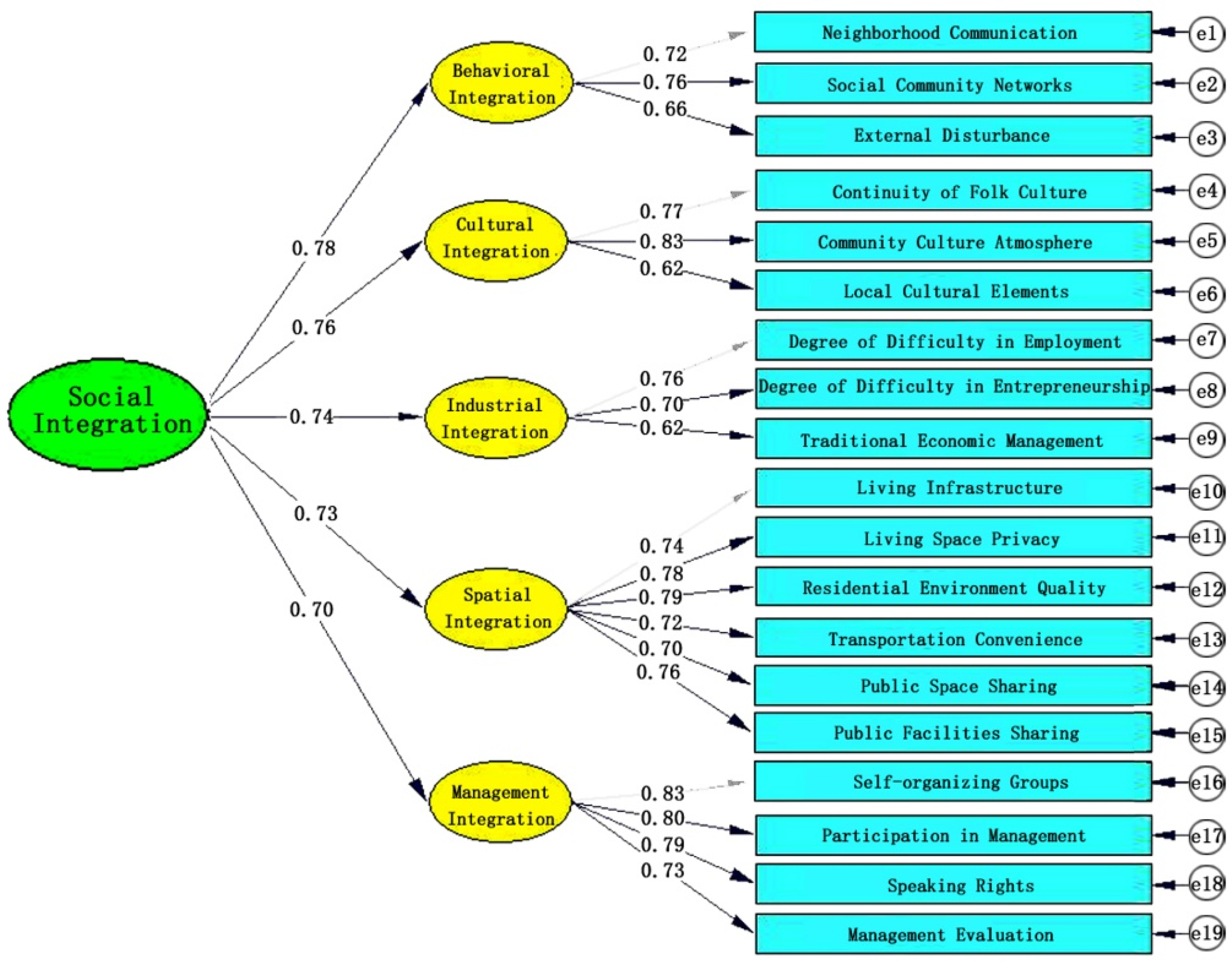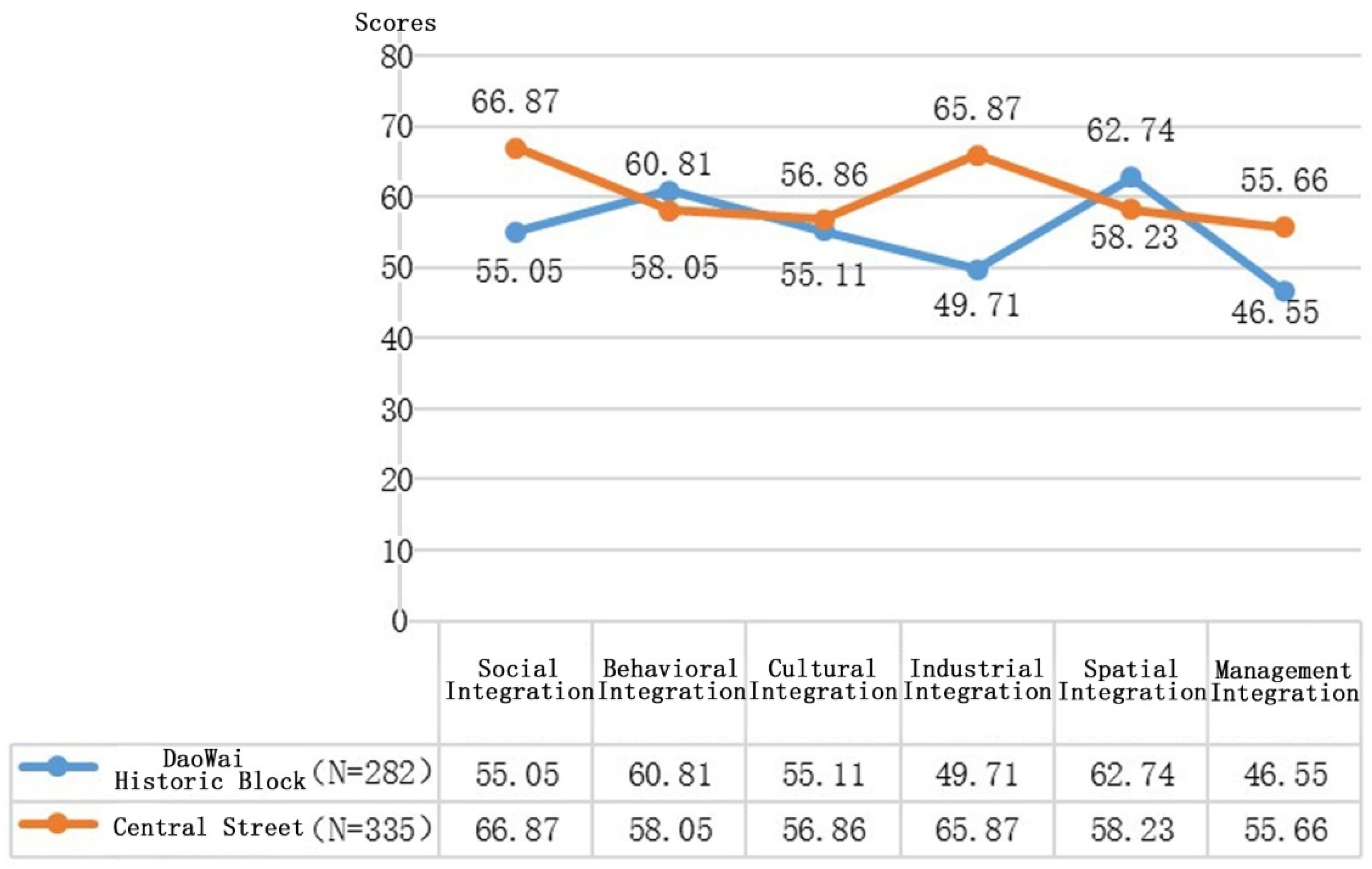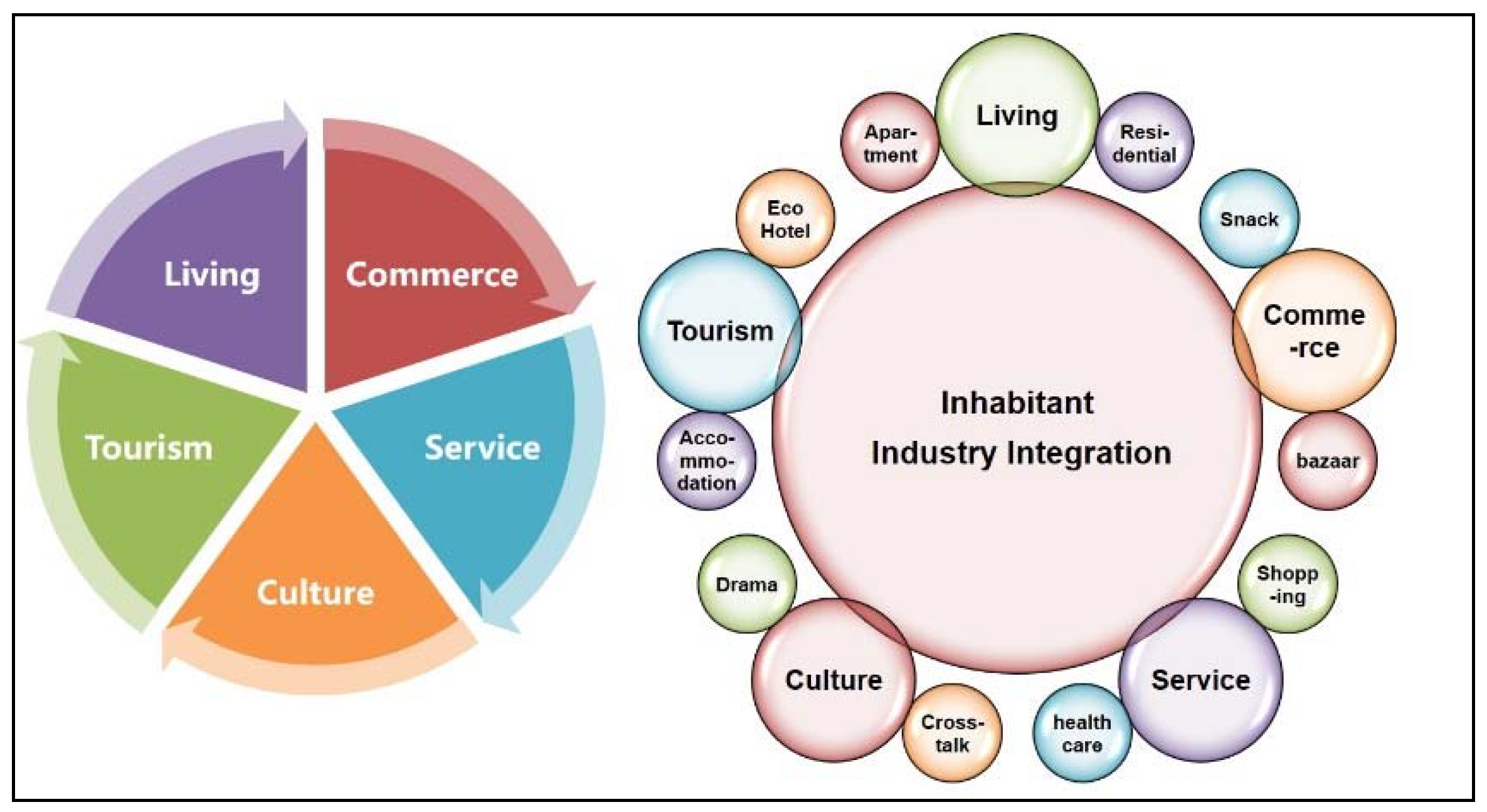1. Introduction
As urbanization accelerates, the social economy, financial resources and the environment are entering a new period with new demands. Equality and social justice have become prominent issues in social development. As a special spatial type within the city, the historic block possesses diversified features. It is not only a space for the development of urban tourism but also a living space that preserves historic charm and cultural sentiment.
At present, due to pursuing the maximization of economic benefits, the interests of inhabitants are generally ignored during the development of historic blocks. As a result of a primarily economic motivation, the reconstruction and renovation of historic districts have not succeeded in addressing the social inclusion of inhabitants and the sustainability of blocks. More social consideration is needed, including a fair right to discourse [
1], protection of the rights and interests of life [
2], the sharing of public space, and more attention to the planning and construction of cities [
3]. Conflicts and contradictions between inhabitants’ lifestyle and tourism business activities are present in China’s historic blocks. Many urban historic districts appear hollowed out. In addition to public holidays and daytime business hours, there are active commercial tourism activities. These hollowed historic blocks are defined by a lack of popularity and daily activities, which leads to a lack of vitality that cannot meet the requirements of sustainable development and the increasing demand for tourist experiences. From the perspectives of public participation and equitable sharing, the interests of inhabitants and social integration issues continue to require resolution.
In recent years, the social issues faced by historic district inhabitants have attracted attention in various areas, including urban planning, sociology, and public health. The academic community has gradually gained insight into the perspective of inhabitants. A number of scholars argue that it is necessary to ensure the retention rate of these inhabitants and to preserve and protect their lifestyles [
1,
4]; cultural inheritance is preserved if it sustains the historic and cultural elements [
5,
6]. Decisions that affect the social integration of low- and middle-income earners require a scientific basis that reflects the goals fairness and a reasonable allocation of resources [
2,
7]. Scholars have attempted to address the question of sustainable renovation through resident perception surveys and typological methods [
8,
9]. Most studies are more inclined to focus on policy mechanisms, public participation evaluation, and resident perception surveys. Researchers have suggested that effective mechanisms should be adopted to resolve conflicts of interest and decrease the power gaps among stakeholders [
10]. The primary mechanism should be public participation evaluation, including mutual trust, equal speaking rights, public interest, and feedback communication [
11]. Scholars have verified that the authenticity of the inhabitants’ lifestyle, public participation, and the residents’ role affect the image and development of tourism destinations [
12,
13]. Other scholars have studied the satisfaction of residents through comprehensive methods, such as city landscape surveys, stakeholder interviews, and property rights sales evaluation [
14]. Studies have investigated the planning and development of historic districts from the perspective of inhabitants. However, there is a lack of research on how to quantify inhabitant social integration.
Social integration became the core concept of Western social policy research and practice in the early 21st century and has been widely addressed by government agencies, social policy researchers, and decision-makers. Social integration is defined as participation in a broad range of social relationships [
15]; it is not a one-way effort but instead involves different social groups for mutual adaptation with the common goal of collaboratively and constructively shaping future life [
16]. Furthermore, social integration is known to positively affect quality of life and health outcomes [
17]. Many scholars believed that it can serve as a source of social stress and motivation to promote people’s mental health [
18,
19,
20,
21], reflected in the interrelationship between the interdependent system of community participation and community integration as a very important measure of social integration [
22].
Social integration is an abstract concept in theory. It can be used to quantify a current situation and its development level. It is an analytical tool for research on social development [
22]. With the development of the theory, developing the distinction between objective and subjective index systems, social integration and social exclusion became the new perspectives from which to measure social integration [
23]. Zhou proposed that only the index system was unified, consistent, and theoretically corresponded to effective measurement (including the design of the questionnaire and subsequent analysis); this index gives the research comparability (it can reflect the similarities and differences between regions and different populations) to reflect the dynamic change of this concept [
24]. The measurement of social integration was pioneered by Park and Burgess, who proposed four measurement dimensions: economic competition, political conflict, social connection, and cultural integration [
25]. Landecker divided these measurement dimensions into cultural integration, communicative integration, functional integration, and normative integration [
26]. Subsequently, many sociological researchers subdivided their classification systems. In 2001, the Social Protection Committee of the European Union proposed 18 measurement indicators grouped into four major systems: integration indicators, pension indicators, health indicators, and long-term care indicators [
27]. The commonly used measures include the size of the network, frequency of contact with network members, and membership in a formal or informal group [
28]. Western research has primarily focused on immigration and ethnicity [
29], including measurement dimensions such as social, political, cultural, and economic integration [
30,
31]. Measurement research in China has focused on migrant workers, floating populations, new urban immigrants, and other groups [
32,
33,
34,
35]. Topics have included economic integration [
35,
36], psychological integration [
37,
38], cultural integration [
27,
39], identity integration [
31,
32,
33,
34,
35], and community integration [
40]. There has been little research on the inhabitants of historic districts. The social culture of such inhabitants differs from that of the international immigrants or domestic floating population who also reside in such districts. However, the social vulnerability of the former group during block reconstruction resembles that of the other transient groups such as the new urban immigrants; they each face similar challenges to their socioeconomic status. Therefore, the measurement of inhabitant social integration can draw on the dimensions of measurement established for similar groups.
In this paper, the two largest historic blocks in Harbin of Heilongjiang Province in China that have the most inhabitants were selected as the research area. After the renewal of the material space, a distinct difference between the vitality of the two blocks emerged. From a sociological perspective, this study investigates whether differences in the sustainable vitality of the neighborhoods are due to differences in the level of social integration of the inhabitants. The purpose and objective of this study is to solve the “host and guest conflict” between the lifestyle of the inhabitant and the tourist trade in the historic blocks, as well as to improve the level of social integration.
To quantify the social integration of inhabitants of historic districts and thus help sustain the vitality of such areas while enhancing social sustainability, this paper constructs a theoretical model to measure inhabitant social integration. The paper adopts exploratory factor analysis (EFA) from Statistical Product and Service Solutions (SPSS) and confirmatory factor analysis (CFA) from the Structural Equation Model (SEM) to statistically analyze survey data of the inhabitants of Harbin’s Central Street and DaoWai historic and cultural blocks in China. In addition, we quantitatively study the factors that influence inhabitant social integration and factor weight to create a model to measure the social integration of the inhabitants of the historic blocks. The comprehensive social integration scores and the scores for each dimension are calculated to perform a comparative analysis of the revitalization of these two historic blocks in Harbin.
According to results, we can intuitively represent the overall level and dimension of the social integration of inhabitants in the historic blocks. Compared to the present situation, it is suggested that the planning should focus on improving the low score of the measurement results to better promote the development of the inhabitant social integration in the historic blocks.
2. Methodology
2.1. Measurement Dimensions and Indicator Selection
There has been no unified view regarding the measurement of social integration. The research has primarily targeted a single research object and discussed its specific influencing factors. The selection of indicators to measure the social integration of the inhabitants of historic districts is mainly based on those applied to urban new immigrants [
38] and with reference to the Sydney Urban Frontier Project (UFP) [
41], which aimed to improve the circumstances of socially vulnerable urban groups. To assess the social issues faced by historic block inhabitants in Harbin, a social integration measurement model with five dimensions was constructed: behavioral integration [
35], cultural integration [
31], industrial integration [
38], spatial integration [
42,
43,
44,
45], and management integration [
27]. Based on a literature review and considering the special conditions of the inhabitants of Harbin’s historic blocks, we initially selected 21 measurement indicators (see
Figure 1).
(1) Behavioral integration. This dimension includes interpersonal communication, living habits, and social behavior [
35]. Here, we primarily draw on dimensions and indicators of social behavior applied in the international migration integration index [
35] and establish three measurement indicators: neighborhood communication, social community networks, and social psychological distance. In addition, to assess the disturbance caused by tourism activities for the historic block inhabitants, we designed a novel indicator: external disturbance.
(2) Cultural integration. This dimension originated in respect to the traditional culture of historic blocks [
31]. Here, we primarily draw on the dimensions and indicators of cultural preservation and acceptance used in research on domestic migrant workers [
39] and the characteristics of community cultural integration noted in the UFP report [
41]. The business culture that emerges from tourism development should seek to continue the cultural atmosphere based on the original street market trade to achieve the integration of the traditional neighborhood culture with the business culture. In this regard, the following three indicators are established: continuity of folk culture, community culture atmosphere, and local cultural elements.
(3) Industrial integration. Here, we primarily refer to the dimensions and indicators of economic integration applied in research on the social integration of a floating population [
36]. Incorporating inhabitant entrepreneurship and employment into industrial integration measurement and considering the traditional economy in the historic blocks, we adopted the following four indicators: degree of difficulty in employment, degree of difficulty in entrepreneurship, traditional economic management, and job satisfaction.
(4) Spatial integration. Based on the suggestions of the UFP report regarding spatial environment planning and integration [
41] on the micro community spatial level, we establish six measurement indicators: living infrastructure, living space privacy, residential environment quality, transportation convenience, public space sharing, and public facilities sharing. The intention was to organically divide and integrate inhabitant living space and tourist public activity space in the physical spatial layout [
43,
44,
45] to resolve the heterogeneity of the two spaces caused by efforts to preserve inhabitant living conditions.
(5) Management integration. Here, we draw on the indicators of social participation in the Atkinson indicator system. These indicators are used in the EU to achieve the “two-in-one” integration of community management and business public administration while establishing a public interest and public participation mechanism on the same platform [
46]. In this manner, an integration management plan with balanced interests can be formed. Here, we develop four measurement indicators: self-organizing groups, participation in management, public speaking rights, and management evaluation.
2.2. Research Object and Data Source
The research samples of this study are located in Harbin, Heilongjiang, China, which was founded in 1898. The Middle East Railway construction and Russian colonial culture had a profound historic impact on its urban construction and architectural style. The samples selected for analysis in this paper were Harbin’s two historic districts with the highest retention rate of inhabitants: Central Street and the DaoWai Historic Block. The location of the two districts is shown in
Figure 2.
The reasons for choosing these two blocks as the research samples are as follows:
(1) They are the two largest historic and cultural blocks with a long history in Harbin, and they cover 940,500 m
2 and 524,450 m
2, respectively, which can be seen in
Figure 3 and
Figure 4. Central Street was built in 1900, and there are 71 historic buildings, such as the Renaissance and Baroque buildings, which reflect the unique architectural culture of Harbin. Central Street is known as “the first street of Asia”. The DaoWai Historic Block was built in 1920 and is the largest Chinese Baroque building block in China. At the end of the 19th century, the historic impact of these two blocks on Harbin consisted of urban construction development and architectural form, which determined the European architectural style and urban features of Harbin. This caused the city to be known as “Oriental Little Paris” in the 20th century.
(2) A large number of inhabitants still live in these two blocks. The number of inhabitants in Central Street is 22,000, and the retention rate is approximately 78%. In the current renovation stage, the number of inhabitants of the DaoWai Historic Block is approximately 8000, with a retention rate of approximately 49%.
(3) In the two blocks, tourist commerce and inhabitants’ daily activities coexist, producing a vivid contrast of activities and cultural blending. Central Street is characterized by the history of the Middle East Railway trade culture and Russian commercial culture. The DaoWai Historic Block is characterized by small traditional commercial business and market culture.
(4) The differences between the two blocks are street size, industrial type, housing price and inhabitants’ standard of living. In addition, after the transformation of material space, there has been a significant difference in the sustainable vitality of the current block. The Central Street block is mainly based on tourist business services. The average housing price is approximately 12,000 RMB/m2, the income level and the quality of life are high, and the vitality of the block is high. The DaoWai Historic Block is mainly based on low-level life services businesses, the average housing price is approximately 5000 RMB/m2, inhabitants’ income level is low, and the vitality of the block is low.
The scope of the study selected in this paper includes the overall scope of the historic block protection zone in Central Street and the DaoWai Historic Block. In Central Street, the protection area and the surrounding environment are coordinated in terms of space, economy, and society. Affected by this, the spatial pattern of the surrounding area is similar to that of Central Street, and the social and economic level is equivalent. At the same time, the intensity of urban construction and development in the surrounding areas has been effectively controlled. Due to the special Chinese Baroque buildings, the spatial types of the DaoWai Historic Block and its surrounding environment are different. The development intensity of the surrounding areas is significantly higher than that of the DaoWai Historic Block, which has had an assimilation effect on the socioeconomic aspects of the surrounding areas. The overall regional socioeconomic level is relatively similar.
The data used in this study were collected using an inhabitant social survey conducted by the project’s team from May to November 2017 in the historic blocks of Harbin’s main urban area. A random sampling method was used for a total of 1099 questionnaires based on different scales and the conditions of inhabitants’ retention. Of the valid recovered questionnaires, 330 were from Central Street and 282 were from the DaoWai Historic Block.
2.3. Survey Method
The survey combined subjective questionnaires and semistructured interviews. A Likert scale was used with the following response options: 1 (strongly disagree), 2 (disagree), 3 (neutral), 4 (agree), and 5 (strongly agree). The questionnaire was completed based on subjective feelings. The Likert scale is a common method to measure social integration [
17]. The questionnaire included a basic demographic survey (e.g., respondent age, identity, income, length of residence) and 21 social integration measures as basic items. For example, “Do you have good communication with your neighbors?” “Do you think the community culture in this block is very good?” “Can you start a business easily in this neighborhood?” “Is the privacy of your space very strong?” “Can you be a good part of the block management?” The scores assigned by the inhabitant respondents for each item were used to transform the sample data into scale variables, and a quantitative statistical analysis was performed. Using SPSS 21.0 statistical software, Statistical Product and Service Solutions, IBM, Chicago, IL, USA, preliminary collation and inspection were performed on the two sets of survey data. Then, reliability analysis was performed on the 21 measurement items included in the survey. For the total sample data for the DaoWai and Central Street blocks, internal consistency reliability coefficient Cronbach’s Alphas were 0.927 and 0.926, respectively, which met statistical reliability requirements. A Bartlett Test for Sphericity and Kaiser–Meyer–Olkin (KMO) analysis were performed on the data. The results indicated a
p-value of 0.000 (
p < 0.001), and the Bartlett test was satisfied. The KMO values were 0.908 and 0.904, respectively. Therefore, the sample data were suitable for factor analysis, and the validity of the scale met normal standards.
2.4. Statistical Analysis Method
To determine the structure of the inhabitants’ social integration measurement indicators in the historic blocks, EFA was performed on the two groups of data samples. The variance maximization method was used to perform rotation in factor load to analyze the principal components. The structure and number of the factors were compared through the variance contribution rate and the common factor variance value, and the irrational factors were eliminated. In this manner, the measurement model structure and factor indicators were initially determined.
CFA of the SEM was used to test the initially determined measurement model through the robust maximum likelihood (MLR) estimator. The model adaptability was good, and the adaptability indicator is shown in
Table 1. In the table, χ
2 means Chi-square, df means degrees of freedom, χ
2/df means ratio of two terms,
p-value means probability level, RMSEA means root mean square error of approximation, NFI means nonnormed fit index, CFI means comparative fit index, IFI means incremental fit index, RFI means relative fit index, and AGFI means adjusted goodness-of-fit index. The SEM method includes the mutual influence of each factor when estimating the model, and the weight value is determined to be the path coefficient obtained from CFA. The inhabitant social integration scores were calculated and converted into values between 1 and 100 according to the standard scores. The factors of each dimension were converted in the same way, resulting in the social integration scores of the inhabitants.
4. Discussion
4.1. Comparison of the Overall Levels of Inhabitant Social Integration
The described measurement model can intuitively quantify the level of inhabitant social integration in the historic blocks, and the social integration status of inhabitants in the different blocks can be reflected by calculating the integrated scores. According to the percentage conversion results, it was found that the inhabitant social integration score for Central Street was higher (66.87), which indicates that Central Street inhabitants had achieved social integration. In addition, the conflict between the inhabitants’ lives, tourism, and commerce was small and trended toward a harmonious level of social integration. The inhabitant social integration score in the DaoWai historic block was lower (55.05). This outcome indicates that social integration there requires improvement. The overall level comparison is consistent with the difference between vitality and sustainability of the two neighborhoods.
A comparison of the actual circumstances of the two historic blocks revealed that the difference in social integration level is primarily due to four factors: the development stage of the blocks, inhabitant characteristics, the initial state of the blocks, and the background resource level of the blocks. First, Harbin’s Central Street is in a period of mature development (the district was established in 1900 and officially transformed into the nation’s first commercial pedestrian street in 1997). Various planning and construction projects have been completed, and development has been steadily advancing. In contrast, the DaoWai historic block remains in the early stage of renovation and development (Street planning was initiated in 2007, and the first phase of the renovation was completed in 2011). The overall demolition of the block has not been completed. Second, generally, the comprehensive social status of the Central Street inhabitants was higher than those of the DaoWai historic block. There are significant differences in the education, employment, and income of the inhabitants. Early in the last century, Central Street had already become an important commercial street in Harbin City, while the DaoWai historic block was a residential district. Thus, there are differences in the initial state of the blocks. Finally, the accumulated background resources of Central Street’s economic and social environment exceed those of the DaoWai historic block. There is also a difference in social attention.
4.2. Comparison of Social Integration Dimension Factors for the Inhabitants of a Single Block
For Central Street, the score comparison results for the five dimensional factors are as follows: industrial integration (65.84) > spatial integration (58.23) > behavioral integration (58.05) > cultural integration (56.86) > management integration (55.66). Industrial integration is the dimension factor with the highest score. This outcome is related to the block’s economic resources. It is relatively common for the inhabitants to be locally employed. The inhabitant spatial integration score ranks second. The inhabitants’ living conditions are generally good, and transportation is convenient. However, most of the living spaces are open street-style dwellings. Therefore, living space privacy is low. The level of public space sharing and facilities must be improved. The level of inhabitant behavioral integration is slightly lower primarily because the numerous tourists who visit the block disturb the inhabitants’ lifestyle activities. The level of cultural integration is low, and the impact of business tourism and assimilation is relatively obvious. The level of inhabitant management integration is the lowest, and there is no inhabitant group organization that would help realize block autonomy. The model of government-dominated development management is continuing.
The plan to enhance inhabitant social integration in Central Street should focus on the dimensions with low scores, that is, on the continuity of the inhabitants’ culture. In this way, the integration of multiple cultures in the block could be balanced. Inhabitant participation in community management should be enhanced to provide the inhabitants implementation responsibility under the current block management system.
In the case of the DaoWai historic block, the score comparison results for the five dimensional factors are as follows: spatial integration (62.74) > behavioral integration (60.81) > cultural integration (55.11) > industrial integration (49.71) > management integration (46.55). Spatial integration is the dimensional factor with the highest score. This outcome is related to the overall shape of the block, that is, the spatial pattern of a main axis connected to auxiliary streets. The extent of disturbance by tourism of inhabitant lifestyle activities is not high. The inhabitant behavior integration score ranks second because there are a relatively large number of retained inhabitants who have preserved their established ways of living. The neighborhood exchanges and social networks are in good condition. Cultural integration and industrial integration did not perform well because of the impacts of the block renovation, business, and trade on the cultural and economic aspects of inhabitant lifestyle activities. The inhabitant management integration score is the lowest. At this stage, the government-dominated development management model cannot achieve the self-living and self-governing model of the inhabitants.
The planning priorities for enhancing the DaoWai historic block should focus on industrial integration and management integration and seek to sustain the block’s traditional economic form, promote local employment and entrepreneurship for block inhabitants, strengthen the public participation of the inhabitants in the block’s renovation, and promote the block’s renovation and development through a cooperative model.
4.3. Comparison of Inhabitant Social Integration Dimension Factors for the Two Blocks
Table 3 compares the dimension factors and the score differences of the two blocks. The analysis found significant differences in industrial integration between the two blocks. The difference in the types of industry and the scales of the two blocks made the largest contributions to the score gap. Central Street has sustained a large-scale, industry-rich commercial and trade model based on the historic foundation of the Western colonial economy. The district is primarily oriented toward international tourism. DaoWai has mainly focused on street business, and the scale is generally small. The clients served by this activity are mostly city residents. The difference in the level of management integration between the two blocks is reflected in the difference in their development stages. Central Street is at a mature stage. However, it lacks public participation from inhabitants. The DaoWai historic block is undergoing reconstruction and renovation, and the block management is dominated by the government. The difference in the spatial integration level is small between the two blocks, and the “bone shape” spatial form of the two blocks renders their living spaces close to the commercial spaces. The spatial integration level of the DaoWai historic block is slightly higher than that of Central Street. The levels of behavioral integration in the two blocks are on par with one another, although the scores of the DaoWai historic block are higher. The difference in cultural integration is the smallest, and the traditional culture of the inhabitants is not prominent. Both blocks require improvement in this aspect.
In summary, planning and development should focus on the identified weaknesses to enhance the social integration of inhabitants of Harbin’s two historic blocks. The key is to promote public participation and thus improve the integration of inhabitants into block management. A long-term interactive management mechanism should be formed by combining autonomous internal inhabitant management with external government management. Behavioral, cultural, and industrial integration should be rationally enhanced. To stimulate the vitality of the blocks, the inhabitants’ culture and economy should be highlighted. Attention should be paid to the functional separation and public sharing of the inhabitants’ living space and the commercial space. In planning historic blocks, inhabitant inclusion should be advocated. Due to the different timing of the development of the blocks, the statistical results of this study reflect the level of inhabitant social integration at the current stage. In this study’s next phase, the sample size of the social survey data will be expanded, and the measurement factor model will be adjusted according to the development stage. In this manner, we will be able to draw conclusions regarding the correlation between inhabitant social integration and population attributes.
4.4. Suggestions for Planning and Policy
The above analysis shows that the difference in industrial integration between the two blocks is the largest among the five dimensional factors, and the difference of cultural integration is the smallest. The study found that differences in the level of inhabitant social integration are the reasons for different levels of vitality and sustainability of neighborhoods. According to the indicators of the inhabitant social integration measurement system and the degree of the two differences, we propose planning and policy improvement suggestions for the following five aspects of the historic blocks in Harbin.
(1) Sharing the benefits of industrial resources and promoting innovation and entrepreneurship
The original business conditions in the historic blocks should be adequately preserved. In particular, historic stores with long-established brands and products that exhibit traditional craftsmanship should be protected. Lifestyle and service business representatives should be improved and supplemented to form an attractive image of the full-scale upgrade and revitalization, giving the blocks an appeal as “a place for living, a place for shopping, and a place for tourism” (see
Figure 8). Priority should be awarded to employing local inhabitants and improving their residential areas. The goal should be to realize a lifestyle of “living here and working here”.
(2) Integrating strictness and flexibility in managing and promoting public participation with multiple subjects
A management committee should be jointly formed by inhabitants, business owners, and management decision-makers to uphold the interests of all parties in the implementation of conservation area planning. In addition, community public management entities should be established to supervise the management and development of the conservation area. The long-term follow-up service for planning implementation should be improved, and a long-term feedback mechanism for public planning management should be established. Inhabitant interest groups in the historic blocks should be established, and the financing of the revitalization of the blocks should be formulated and discussed in phases.
(3) Integrating the layout of the spatial environment and people-oriented planning
The planning of historic blocks should divide quiet areas from busy areas to achieve functional separation. Plant landscaping and landscaping techniques for small facilities can be used to isolate residential space from business and commercial space. Signs that identify private residences can be used to minimize the conflict arising from the mutual disturbance of hosts and guests in the historic blocks. In addition, the inhabitants’ social integration should be incorporated into the planning, and planning decisions should emphasize the measurement and evaluation of inhabitant social integration.
(4) Behavioral integration promotes interaction and reduces host-guest conflicts
Planning should first consider a compensation plan for inhabitants who had to relocate during the initial stage of reconstruction. It must also reduce conflict as much as possible and retain as many inhabitants as possible, ensuring a stable inhabitant retention rate. To promote interaction, the protection and preservation of long-established houses and courtyards should be maintained along with the ecology of the historic blocks. More public space, such as “pocket parks”, should be laid out spatially, and green nodes with a radius of 100 m should be planned (see
Figure 9).
(5) Regeneration of cultural resources and the creation of traditional folk brands
Symbols of the traditional culture and the identity of the historic blocks should be protected and widely used in the architecture and design of large and small structures to improve the district’s visual appearance and acoustic environment. Considering the need to reduce the impact on the inhabitants, tourist traffic should be strictly controlled to promote sustainable, stable tourism development in the historic blocks.

